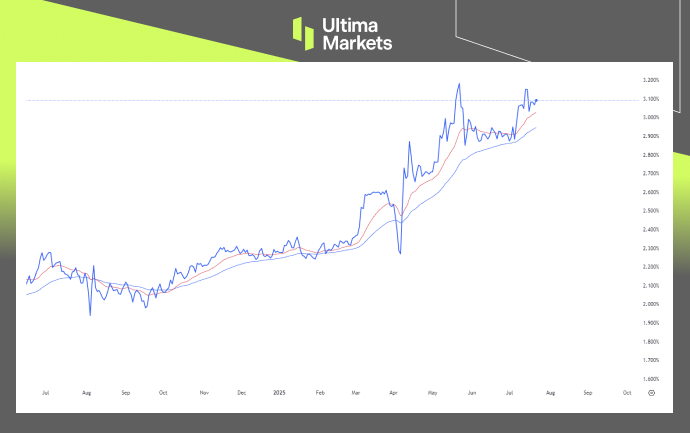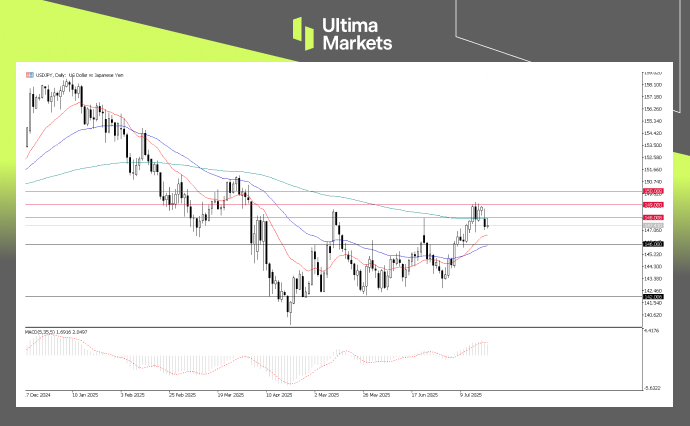US-Japan Tariff Tensions Mount: JGBs & Yen on the Brink?
On July 12, U.S. President Donald Trump announced a sweeping new round of tariffs affecting 14 countries—including a 25% tariff on Japanese exports—while extending the negotiation deadline to August 1.
These tariffs target key sectors such as automobiles, steel, aluminum, and copper and are framed under the principle of “reciprocal” treatment. If no agreement is reached by the deadline, the U.S. will implement a blanket 25% tariff on all Japanese imports.
Japan, among the first countries to initiate direct tariff negotiations with Washington, has made little visible progress. This lack of clarity has intensified market concern—not only over trade fallout but also over broader implications for the Japanese yen, economic outlook, and stock market performance.
U.S.–Japan Tariff Talks: Still Ongoing, Still Challenging
Despite several rounds of dialogue—including recent calls between Japan’s Trade Minister Ryosei Akazawa and U.S. Commerce Secretary Howard Lutnick—no substantial breakthrough has been achieved.
Japan continues to defend its red lines, insisting that automobiles and agriculture are non-negotiable, especially amid rising domestic political pressure.
Latest Developments:
- High-level engagement continues: Japan’s chief negotiator Akazawa recently held a 45-minute phone discussion with Commerce Secretary Lutnick. Both sides reaffirmed their positions while committing to continued dialogue.
- In-person talks expected: Akazawa confirmed plans to travel to Washington next week for further meetings with Lutnick and U.S. Treasury Secretary Scott Bessent, aiming to secure a deal before the August 1 deadline.
- U.S. signals cautious optimism: After meeting Japanese Prime Minister Shigeru Ishiba in Tokyo, Bessent stated that a “mutually beneficial trade agreement” remains possible, though he emphasized quality over speed.
Japan, however, remains firm: any trade deal must include tariff relief for its vital automobile sector. Without such concessions, Tokyo has signaled it will not move forward. This issue remains the key sticking point, as U.S. negotiators stand by the “reciprocal treatment” principle outlined by President Trump.
Political Fallout: Japan’s Upper House Election Adds Complexity
The slow pace of trade talks is not just a matter of policy differences—domestic political instability in Japan is further complicating matters.
On July 20, Japan’s Upper House election delivered a major blow to the ruling coalition. Prime Minister Shigeru Ishiba’s Liberal Democratic Party (LDP), along with junior partner Komeito, secured only 47 of the 50 seats needed to maintain a majority in the 248-seat chamber. As a result, the coalition has lost control of both parliamentary houses for the first time since 1955.
Despite the setback, Ishiba has vowed to remain in office and continue “critical tariff negotiations with the United States.” However, his leadership is under increasing scrutiny, with internal LDP factions and former Prime Ministers openly discussing potential leadership changes. The opposition is also considering a no-confidence motion, further clouding Japan’s policy outlook.
This political uncertainty weakens Japan’s negotiating hand and makes it harder to pursue bold concessions without risking domestic backlash.
Japanese Yen and JGBs Under Pressure
The ongoing tariff standoff and rising political uncertainty are beginning to reverberate through Japan’s financial markets. Both the Japanese yen (JPY) and Japanese Government Bonds (JGBs) are coming under growing pressure, as investor confidence weakens.
JGB Yields Hit Multi-Month Highs
Long-dated JGB yields, particularly the 30-year tenor, have climbed to multi-month highs. This rise reflects fears that Ishiba’s administration could resort to aggressive stimulus—such as tax cuts, cash handouts, or sector-specific relief—to regain public support.
These measures would deepen Japan’s fiscal burdens, potentially triggering a broader bond selloff. Moreover, if economic conditions worsen, the Bank of Japan may be forced to adjust its ultra-loose policy, injecting further volatility into bond and currency markets.

Japan Government Bond 30-Year Yield | Source: LSEG , Chart: Trading View
Japanese Yen: 150-Psychological Level in Play
In the currency market, the Japanese yen has weakened notably against the U.S. dollar, despite broader dollar softness. The USD/JPY pair has climbed to 149, marking a two-month low for the yen and making it the weakest among major currencies.

USDJPY, Day Chart Analysis | Source: Ultima Market MT5
In the FX space, the Japanese yen has depreciated notably against the U.S. dollar, despite general dollar softness. The USD/JPY pair has climbed to 149, marking a two-month low for the yen and making it the weakest performer among major currencies.
From a technical standpoint, USD/JPY has returned to multi-month highs in the 148–149 range. This move is particularly noteworthy as the pair approaches the psychologically significant 150 level—a potential pivot point for market sentiment and policy response.
What Could Be Next for the Yen
Looking ahead, the Japanese yen is clearly under pressure, and the remainder of Q3 could prove particularly volatile. Several key factors are likely to shape the currency’s direction in the weeks to come.
What’s weighing on the yen?
The biggest risk remains the U.S.–Japan trade talks. Should negotiations break down or fail to deliver meaningful compromise—especially on auto tariffs—the yen could see renewed selling. Domestic headwinds, including political instability, rising fiscal uncertainty, and a weakening macroeconomic backdrop, only compound the bearish outlook.
What could support the yen?
On the other hand, the 150 level in USD/JPY looms large. This threshold has historically drawn the attention of Japanese policymakers. Market participants are watching closely for signs of intervention—or at least verbal warnings—from the Bank of Japan or Ministry of Finance.
Additionally, President Trump has previously expressed dissatisfaction with the yen’s depreciation, which could emerge as a bargaining chip in ongoing trade talks. If intervention risks rise or 150 proves to be a technical ceiling, the yen may find short-term support.
Tariff Countdown Sparks Yen Volatility Concerns
The Japanese yen is expected to face heightened volatility heading into the August 1st U.S.–Japan tariff deadline, with Q3 likely to remain turbulent. Trade negotiations remain uncertain, political instability following Japan’s Upper House election adds pressure, and rising fiscal concerns are weighing on investor confidence.
With USD/JPY nearing the critical 150 level, markets are also on alert for potential intervention from Japanese authorities. These combined factors suggest a volatile path ahead for the yen.
Disclaimer
Comments, news, research, analysis, price, and all information contained in the article only serve as general information for readers and do not suggest any advice. Ultima Markets has taken reasonable measures to provide up-to-date information, but cannot guarantee accuracy, and may modify without notice. Ultima Markets will not be responsible for any loss incurred due to the application of the information provided.
Why Trade Metals & Commodities with Ultima Markets?
Ultima Markets provides the foremost competitive cost and exchange environment for prevalent commodities worldwide.
Start TradingMonitoring the market on the go
Markets are susceptible to changes in supply and demand
Attractive to investors only interested in price speculation
Deep and diverse liquidity with no hidden fees
No dealing desk and no requotes
Fast execution via Equinix NY4 server









